Organisational Behaviour: Perception, Decision-Making and Conflicts
VerifiedAdded on 2020/03/07
|10
|2979
|55
Essay
AI Summary
This essay delves into the multifaceted realm of organisational behaviour, focusing on how perception shapes individual actions and decision-making processes within an organisation. It explores the factors that influence perception, including the perceiver, the target, and the situation, and how these elements contribute to biases in judgment. The essay examines the importance of clear role perceptions for employees and discusses various decision-making styles, highlighting the rational decision-making process and the biases that can impede effective choices. Furthermore, it addresses value conflicts within organisations and their implications for management. The content also covers the connection of perception with decision making of an individual, the assumption related to the rational decision making, issues related in the process of the decision making, Biases in the process of the decision making, and differences in the decision making styles of the individuals. The essay concludes by emphasizing the significance of understanding perception to foster a productive and harmonious work environment. The essay also uses the application of perception in the organisation.
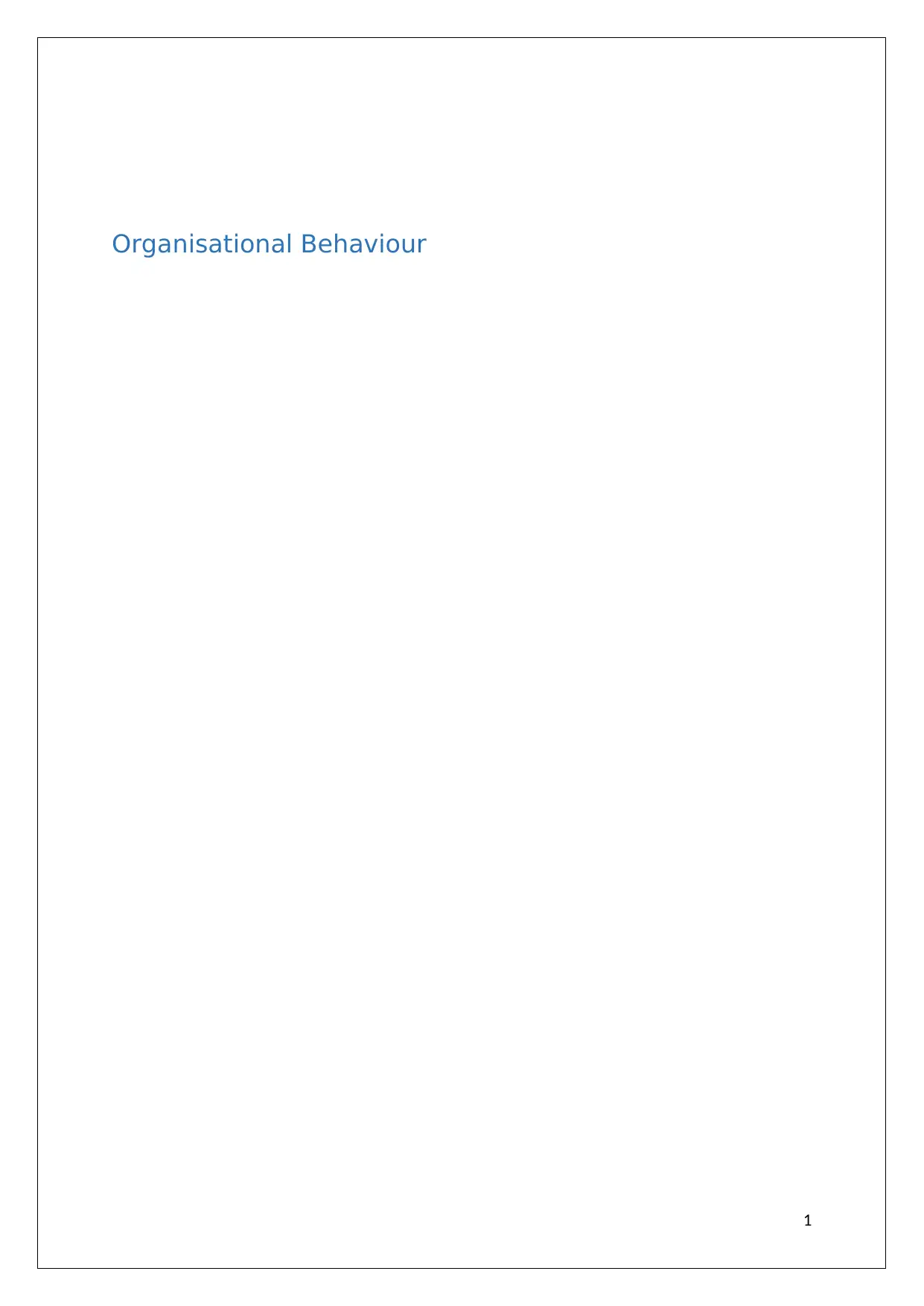
Organisational Behaviour
1
1
Paraphrase This Document
Need a fresh take? Get an instant paraphrase of this document with our AI Paraphraser
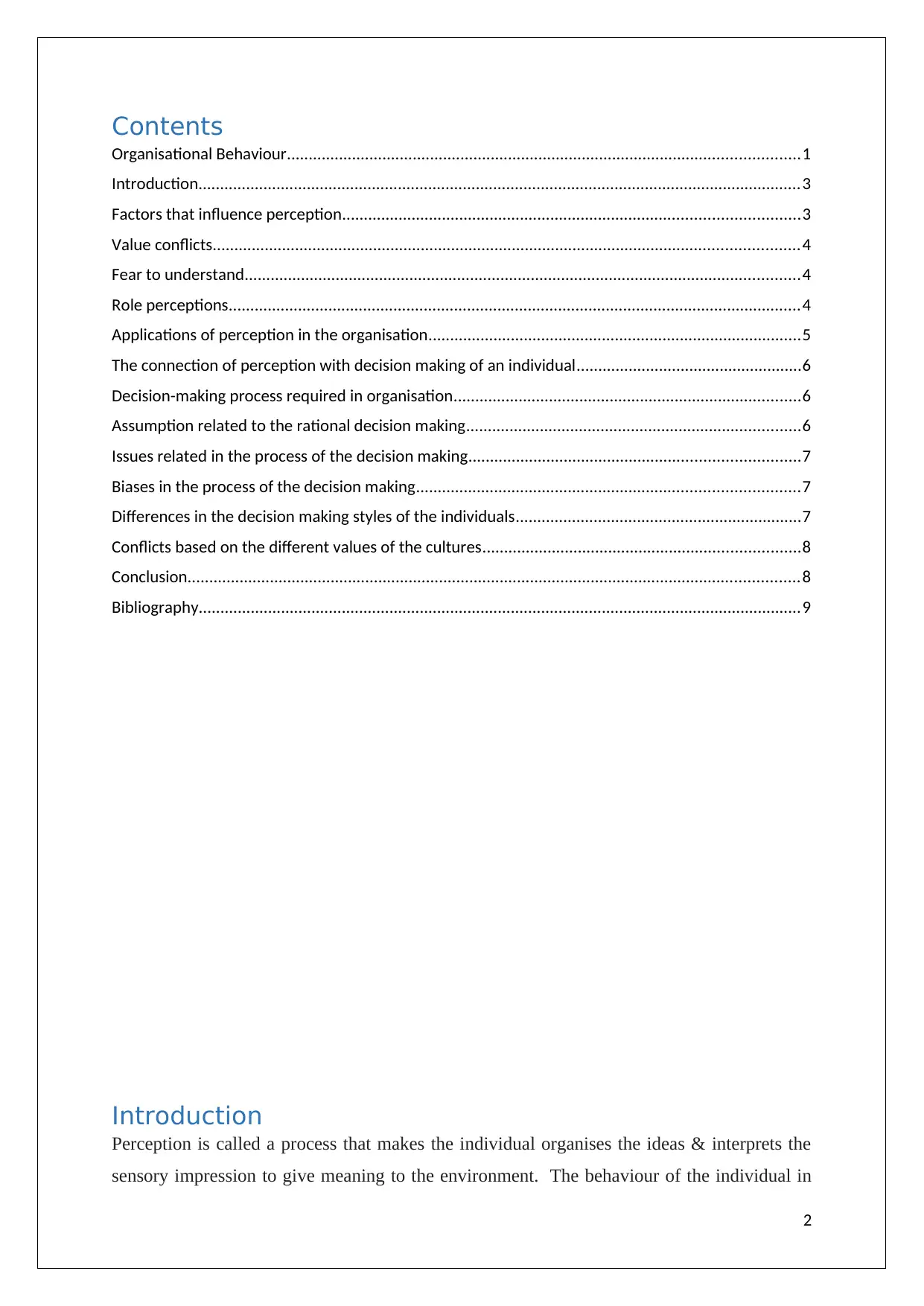
Contents
Organisational Behaviour......................................................................................................................1
Introduction...........................................................................................................................................3
Factors that influence perception.........................................................................................................3
Value conflicts.......................................................................................................................................4
Fear to understand................................................................................................................................4
Role perceptions....................................................................................................................................4
Applications of perception in the organisation......................................................................................5
The connection of perception with decision making of an individual....................................................6
Decision-making process required in organisation................................................................................6
Assumption related to the rational decision making.............................................................................6
Issues related in the process of the decision making............................................................................7
Biases in the process of the decision making........................................................................................7
Differences in the decision making styles of the individuals..................................................................7
Conflicts based on the different values of the cultures.........................................................................8
Conclusion.............................................................................................................................................8
Bibliography...........................................................................................................................................9
Introduction
Perception is called a process that makes the individual organises the ideas & interprets the
sensory impression to give meaning to the environment. The behaviour of the individual in
2
Organisational Behaviour......................................................................................................................1
Introduction...........................................................................................................................................3
Factors that influence perception.........................................................................................................3
Value conflicts.......................................................................................................................................4
Fear to understand................................................................................................................................4
Role perceptions....................................................................................................................................4
Applications of perception in the organisation......................................................................................5
The connection of perception with decision making of an individual....................................................6
Decision-making process required in organisation................................................................................6
Assumption related to the rational decision making.............................................................................6
Issues related in the process of the decision making............................................................................7
Biases in the process of the decision making........................................................................................7
Differences in the decision making styles of the individuals..................................................................7
Conflicts based on the different values of the cultures.........................................................................8
Conclusion.............................................................................................................................................8
Bibliography...........................................................................................................................................9
Introduction
Perception is called a process that makes the individual organises the ideas & interprets the
sensory impression to give meaning to the environment. The behaviour of the individual in
2
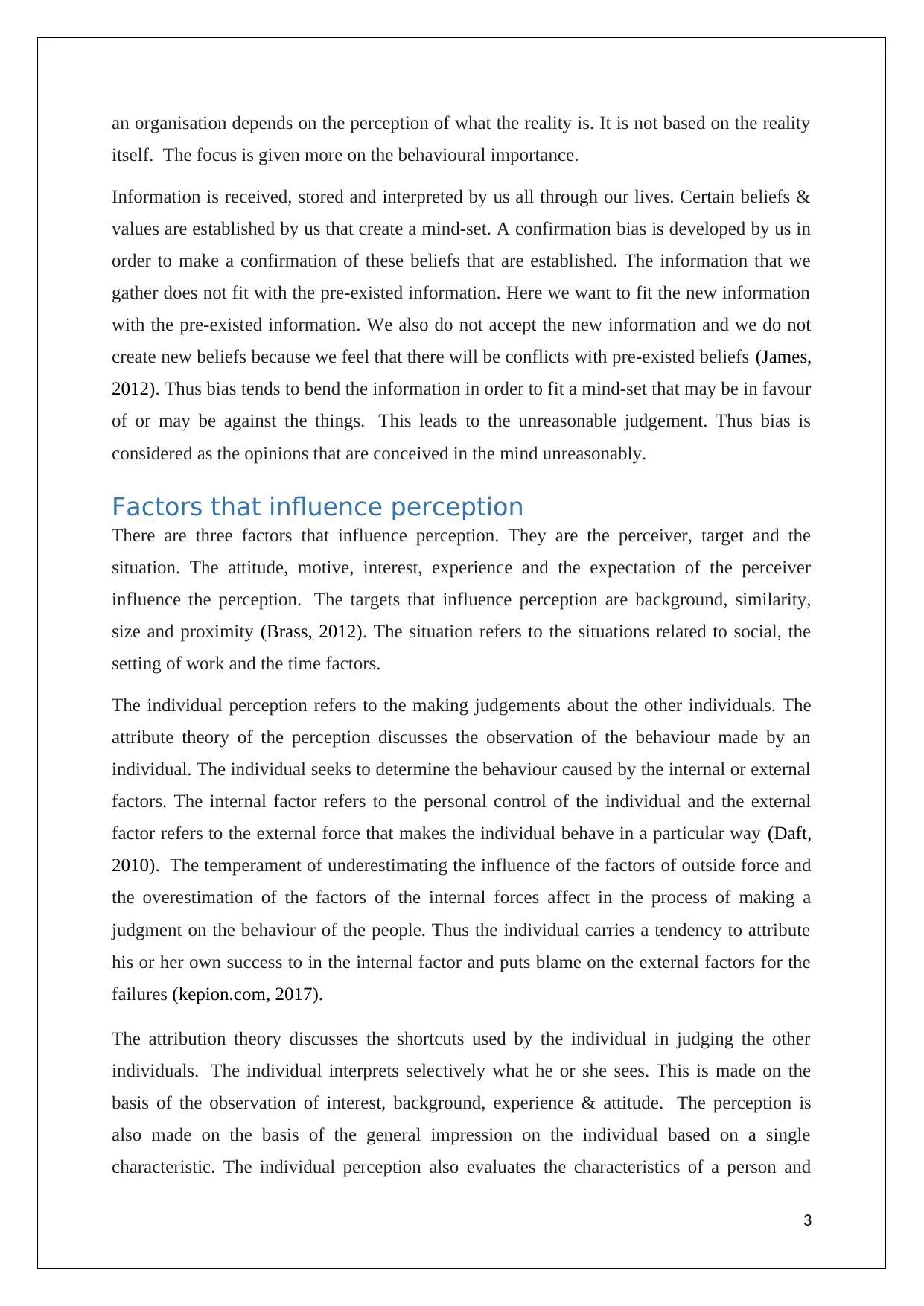
an organisation depends on the perception of what the reality is. It is not based on the reality
itself. The focus is given more on the behavioural importance.
Information is received, stored and interpreted by us all through our lives. Certain beliefs &
values are established by us that create a mind-set. A confirmation bias is developed by us in
order to make a confirmation of these beliefs that are established. The information that we
gather does not fit with the pre-existed information. Here we want to fit the new information
with the pre-existed information. We also do not accept the new information and we do not
create new beliefs because we feel that there will be conflicts with pre-existed beliefs (James,
2012). Thus bias tends to bend the information in order to fit a mind-set that may be in favour
of or may be against the things. This leads to the unreasonable judgement. Thus bias is
considered as the opinions that are conceived in the mind unreasonably.
Factors that influence perception
There are three factors that influence perception. They are the perceiver, target and the
situation. The attitude, motive, interest, experience and the expectation of the perceiver
influence the perception. The targets that influence perception are background, similarity,
size and proximity (Brass, 2012). The situation refers to the situations related to social, the
setting of work and the time factors.
The individual perception refers to the making judgements about the other individuals. The
attribute theory of the perception discusses the observation of the behaviour made by an
individual. The individual seeks to determine the behaviour caused by the internal or external
factors. The internal factor refers to the personal control of the individual and the external
factor refers to the external force that makes the individual behave in a particular way (Daft,
2010). The temperament of underestimating the influence of the factors of outside force and
the overestimation of the factors of the internal forces affect in the process of making a
judgment on the behaviour of the people. Thus the individual carries a tendency to attribute
his or her own success to in the internal factor and puts blame on the external factors for the
failures (kepion.com, 2017).
The attribution theory discusses the shortcuts used by the individual in judging the other
individuals. The individual interprets selectively what he or she sees. This is made on the
basis of the observation of interest, background, experience & attitude. The perception is
also made on the basis of the general impression on the individual based on a single
characteristic. The individual perception also evaluates the characteristics of a person and
3
itself. The focus is given more on the behavioural importance.
Information is received, stored and interpreted by us all through our lives. Certain beliefs &
values are established by us that create a mind-set. A confirmation bias is developed by us in
order to make a confirmation of these beliefs that are established. The information that we
gather does not fit with the pre-existed information. Here we want to fit the new information
with the pre-existed information. We also do not accept the new information and we do not
create new beliefs because we feel that there will be conflicts with pre-existed beliefs (James,
2012). Thus bias tends to bend the information in order to fit a mind-set that may be in favour
of or may be against the things. This leads to the unreasonable judgement. Thus bias is
considered as the opinions that are conceived in the mind unreasonably.
Factors that influence perception
There are three factors that influence perception. They are the perceiver, target and the
situation. The attitude, motive, interest, experience and the expectation of the perceiver
influence the perception. The targets that influence perception are background, similarity,
size and proximity (Brass, 2012). The situation refers to the situations related to social, the
setting of work and the time factors.
The individual perception refers to the making judgements about the other individuals. The
attribute theory of the perception discusses the observation of the behaviour made by an
individual. The individual seeks to determine the behaviour caused by the internal or external
factors. The internal factor refers to the personal control of the individual and the external
factor refers to the external force that makes the individual behave in a particular way (Daft,
2010). The temperament of underestimating the influence of the factors of outside force and
the overestimation of the factors of the internal forces affect in the process of making a
judgment on the behaviour of the people. Thus the individual carries a tendency to attribute
his or her own success to in the internal factor and puts blame on the external factors for the
failures (kepion.com, 2017).
The attribution theory discusses the shortcuts used by the individual in judging the other
individuals. The individual interprets selectively what he or she sees. This is made on the
basis of the observation of interest, background, experience & attitude. The perception is
also made on the basis of the general impression on the individual based on a single
characteristic. The individual perception also evaluates the characteristics of a person and
3
⊘ This is a preview!⊘
Do you want full access?
Subscribe today to unlock all pages.

Trusted by 1+ million students worldwide
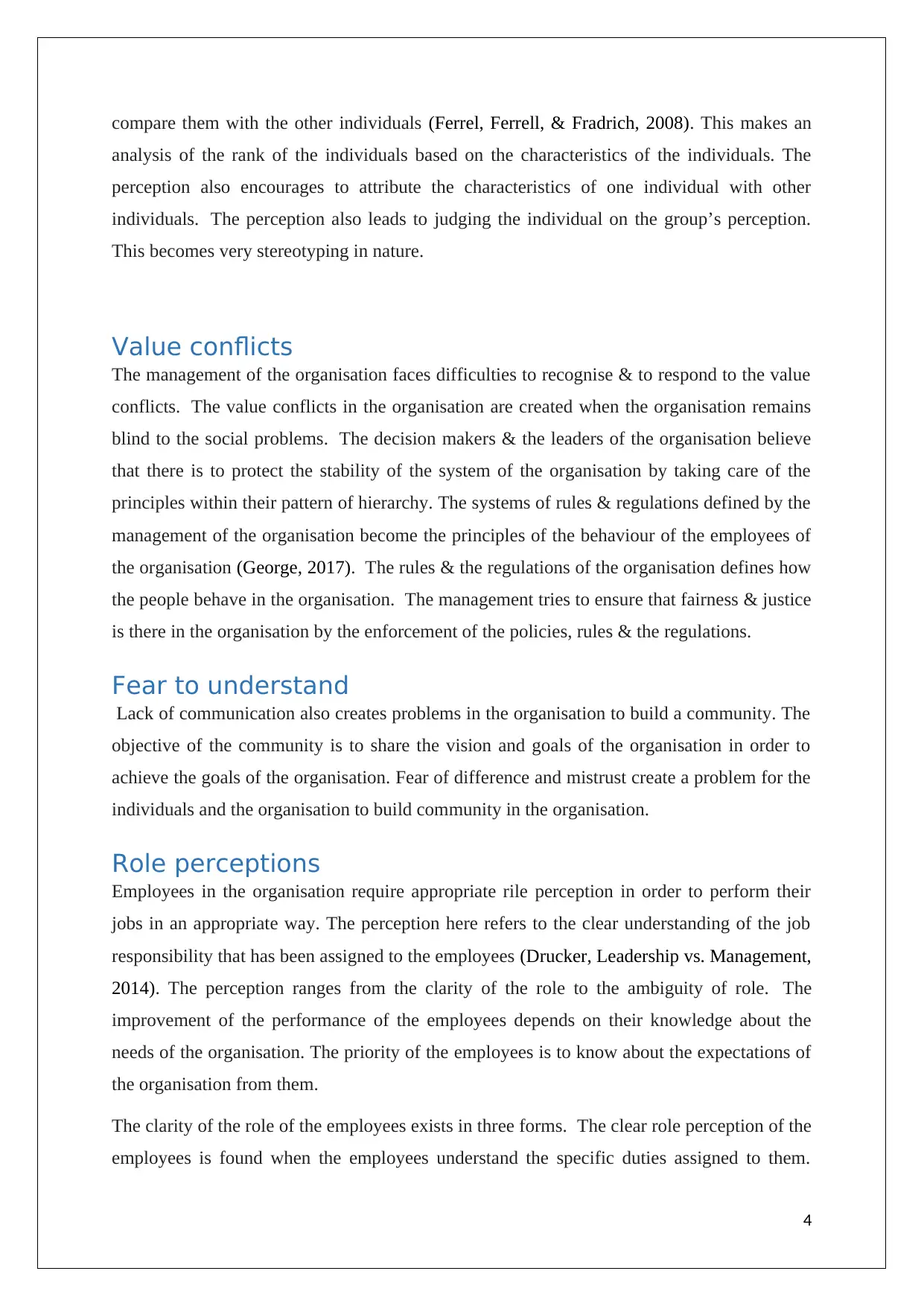
compare them with the other individuals (Ferrel, Ferrell, & Fradrich, 2008). This makes an
analysis of the rank of the individuals based on the characteristics of the individuals. The
perception also encourages to attribute the characteristics of one individual with other
individuals. The perception also leads to judging the individual on the group’s perception.
This becomes very stereotyping in nature.
Value conflicts
The management of the organisation faces difficulties to recognise & to respond to the value
conflicts. The value conflicts in the organisation are created when the organisation remains
blind to the social problems. The decision makers & the leaders of the organisation believe
that there is to protect the stability of the system of the organisation by taking care of the
principles within their pattern of hierarchy. The systems of rules & regulations defined by the
management of the organisation become the principles of the behaviour of the employees of
the organisation (George, 2017). The rules & the regulations of the organisation defines how
the people behave in the organisation. The management tries to ensure that fairness & justice
is there in the organisation by the enforcement of the policies, rules & the regulations.
Fear to understand
Lack of communication also creates problems in the organisation to build a community. The
objective of the community is to share the vision and goals of the organisation in order to
achieve the goals of the organisation. Fear of difference and mistrust create a problem for the
individuals and the organisation to build community in the organisation.
Role perceptions
Employees in the organisation require appropriate rile perception in order to perform their
jobs in an appropriate way. The perception here refers to the clear understanding of the job
responsibility that has been assigned to the employees (Drucker, Leadership vs. Management,
2014). The perception ranges from the clarity of the role to the ambiguity of role. The
improvement of the performance of the employees depends on their knowledge about the
needs of the organisation. The priority of the employees is to know about the expectations of
the organisation from them.
The clarity of the role of the employees exists in three forms. The clear role perception of the
employees is found when the employees understand the specific duties assigned to them.
4
analysis of the rank of the individuals based on the characteristics of the individuals. The
perception also encourages to attribute the characteristics of one individual with other
individuals. The perception also leads to judging the individual on the group’s perception.
This becomes very stereotyping in nature.
Value conflicts
The management of the organisation faces difficulties to recognise & to respond to the value
conflicts. The value conflicts in the organisation are created when the organisation remains
blind to the social problems. The decision makers & the leaders of the organisation believe
that there is to protect the stability of the system of the organisation by taking care of the
principles within their pattern of hierarchy. The systems of rules & regulations defined by the
management of the organisation become the principles of the behaviour of the employees of
the organisation (George, 2017). The rules & the regulations of the organisation defines how
the people behave in the organisation. The management tries to ensure that fairness & justice
is there in the organisation by the enforcement of the policies, rules & the regulations.
Fear to understand
Lack of communication also creates problems in the organisation to build a community. The
objective of the community is to share the vision and goals of the organisation in order to
achieve the goals of the organisation. Fear of difference and mistrust create a problem for the
individuals and the organisation to build community in the organisation.
Role perceptions
Employees in the organisation require appropriate rile perception in order to perform their
jobs in an appropriate way. The perception here refers to the clear understanding of the job
responsibility that has been assigned to the employees (Drucker, Leadership vs. Management,
2014). The perception ranges from the clarity of the role to the ambiguity of role. The
improvement of the performance of the employees depends on their knowledge about the
needs of the organisation. The priority of the employees is to know about the expectations of
the organisation from them.
The clarity of the role of the employees exists in three forms. The clear role perception of the
employees is found when the employees understand the specific duties assigned to them.
4
Paraphrase This Document
Need a fresh take? Get an instant paraphrase of this document with our AI Paraphraser
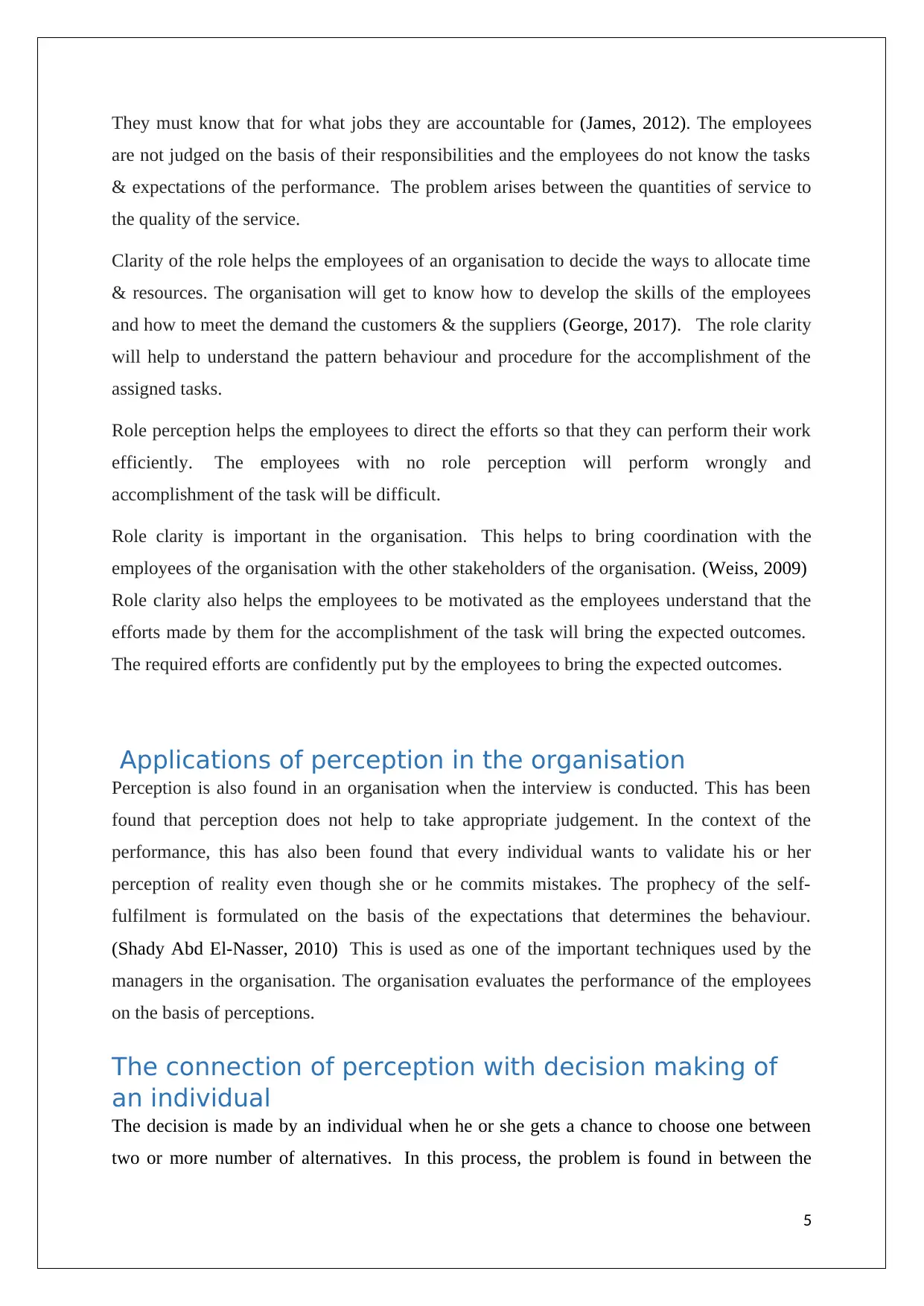
They must know that for what jobs they are accountable for (James, 2012). The employees
are not judged on the basis of their responsibilities and the employees do not know the tasks
& expectations of the performance. The problem arises between the quantities of service to
the quality of the service.
Clarity of the role helps the employees of an organisation to decide the ways to allocate time
& resources. The organisation will get to know how to develop the skills of the employees
and how to meet the demand the customers & the suppliers (George, 2017). The role clarity
will help to understand the pattern behaviour and procedure for the accomplishment of the
assigned tasks.
Role perception helps the employees to direct the efforts so that they can perform their work
efficiently. The employees with no role perception will perform wrongly and
accomplishment of the task will be difficult.
Role clarity is important in the organisation. This helps to bring coordination with the
employees of the organisation with the other stakeholders of the organisation. (Weiss, 2009)
Role clarity also helps the employees to be motivated as the employees understand that the
efforts made by them for the accomplishment of the task will bring the expected outcomes.
The required efforts are confidently put by the employees to bring the expected outcomes.
Applications of perception in the organisation
Perception is also found in an organisation when the interview is conducted. This has been
found that perception does not help to take appropriate judgement. In the context of the
performance, this has also been found that every individual wants to validate his or her
perception of reality even though she or he commits mistakes. The prophecy of the self-
fulfilment is formulated on the basis of the expectations that determines the behaviour.
(Shady Abd El-Nasser, 2010) This is used as one of the important techniques used by the
managers in the organisation. The organisation evaluates the performance of the employees
on the basis of perceptions.
The connection of perception with decision making of
an individual
The decision is made by an individual when he or she gets a chance to choose one between
two or more number of alternatives. In this process, the problem is found in between the
5
are not judged on the basis of their responsibilities and the employees do not know the tasks
& expectations of the performance. The problem arises between the quantities of service to
the quality of the service.
Clarity of the role helps the employees of an organisation to decide the ways to allocate time
& resources. The organisation will get to know how to develop the skills of the employees
and how to meet the demand the customers & the suppliers (George, 2017). The role clarity
will help to understand the pattern behaviour and procedure for the accomplishment of the
assigned tasks.
Role perception helps the employees to direct the efforts so that they can perform their work
efficiently. The employees with no role perception will perform wrongly and
accomplishment of the task will be difficult.
Role clarity is important in the organisation. This helps to bring coordination with the
employees of the organisation with the other stakeholders of the organisation. (Weiss, 2009)
Role clarity also helps the employees to be motivated as the employees understand that the
efforts made by them for the accomplishment of the task will bring the expected outcomes.
The required efforts are confidently put by the employees to bring the expected outcomes.
Applications of perception in the organisation
Perception is also found in an organisation when the interview is conducted. This has been
found that perception does not help to take appropriate judgement. In the context of the
performance, this has also been found that every individual wants to validate his or her
perception of reality even though she or he commits mistakes. The prophecy of the self-
fulfilment is formulated on the basis of the expectations that determines the behaviour.
(Shady Abd El-Nasser, 2010) This is used as one of the important techniques used by the
managers in the organisation. The organisation evaluates the performance of the employees
on the basis of perceptions.
The connection of perception with decision making of
an individual
The decision is made by an individual when he or she gets a chance to choose one between
two or more number of alternatives. In this process, the problem is found in between the
5
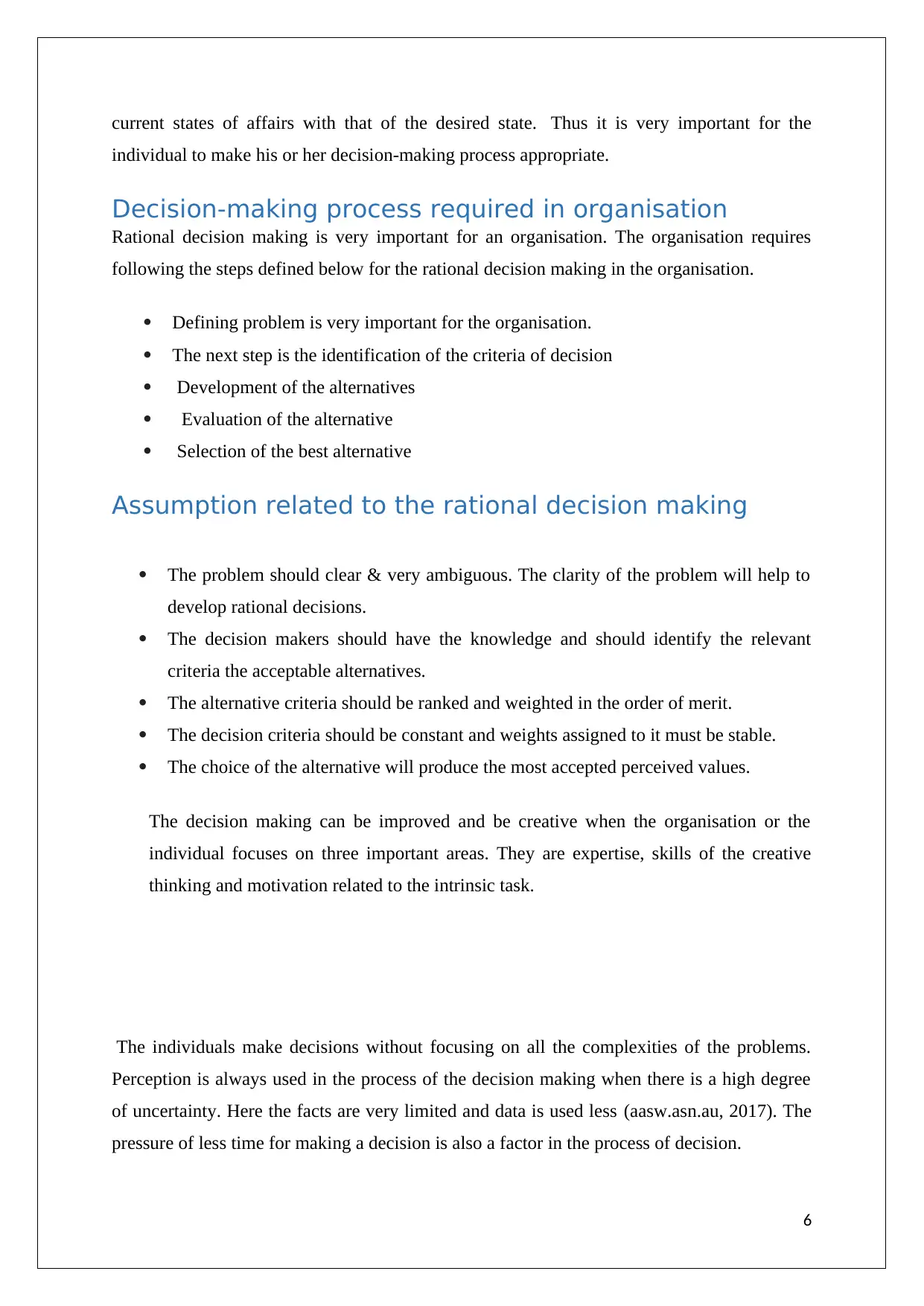
current states of affairs with that of the desired state. Thus it is very important for the
individual to make his or her decision-making process appropriate.
Decision-making process required in organisation
Rational decision making is very important for an organisation. The organisation requires
following the steps defined below for the rational decision making in the organisation.
Defining problem is very important for the organisation.
The next step is the identification of the criteria of decision
Development of the alternatives
Evaluation of the alternative
Selection of the best alternative
Assumption related to the rational decision making
The problem should clear & very ambiguous. The clarity of the problem will help to
develop rational decisions.
The decision makers should have the knowledge and should identify the relevant
criteria the acceptable alternatives.
The alternative criteria should be ranked and weighted in the order of merit.
The decision criteria should be constant and weights assigned to it must be stable.
The choice of the alternative will produce the most accepted perceived values.
The decision making can be improved and be creative when the organisation or the
individual focuses on three important areas. They are expertise, skills of the creative
thinking and motivation related to the intrinsic task.
The individuals make decisions without focusing on all the complexities of the problems.
Perception is always used in the process of the decision making when there is a high degree
of uncertainty. Here the facts are very limited and data is used less (aasw.asn.au, 2017). The
pressure of less time for making a decision is also a factor in the process of decision.
6
individual to make his or her decision-making process appropriate.
Decision-making process required in organisation
Rational decision making is very important for an organisation. The organisation requires
following the steps defined below for the rational decision making in the organisation.
Defining problem is very important for the organisation.
The next step is the identification of the criteria of decision
Development of the alternatives
Evaluation of the alternative
Selection of the best alternative
Assumption related to the rational decision making
The problem should clear & very ambiguous. The clarity of the problem will help to
develop rational decisions.
The decision makers should have the knowledge and should identify the relevant
criteria the acceptable alternatives.
The alternative criteria should be ranked and weighted in the order of merit.
The decision criteria should be constant and weights assigned to it must be stable.
The choice of the alternative will produce the most accepted perceived values.
The decision making can be improved and be creative when the organisation or the
individual focuses on three important areas. They are expertise, skills of the creative
thinking and motivation related to the intrinsic task.
The individuals make decisions without focusing on all the complexities of the problems.
Perception is always used in the process of the decision making when there is a high degree
of uncertainty. Here the facts are very limited and data is used less (aasw.asn.au, 2017). The
pressure of less time for making a decision is also a factor in the process of decision.
6
⊘ This is a preview!⊘
Do you want full access?
Subscribe today to unlock all pages.

Trusted by 1+ million students worldwide
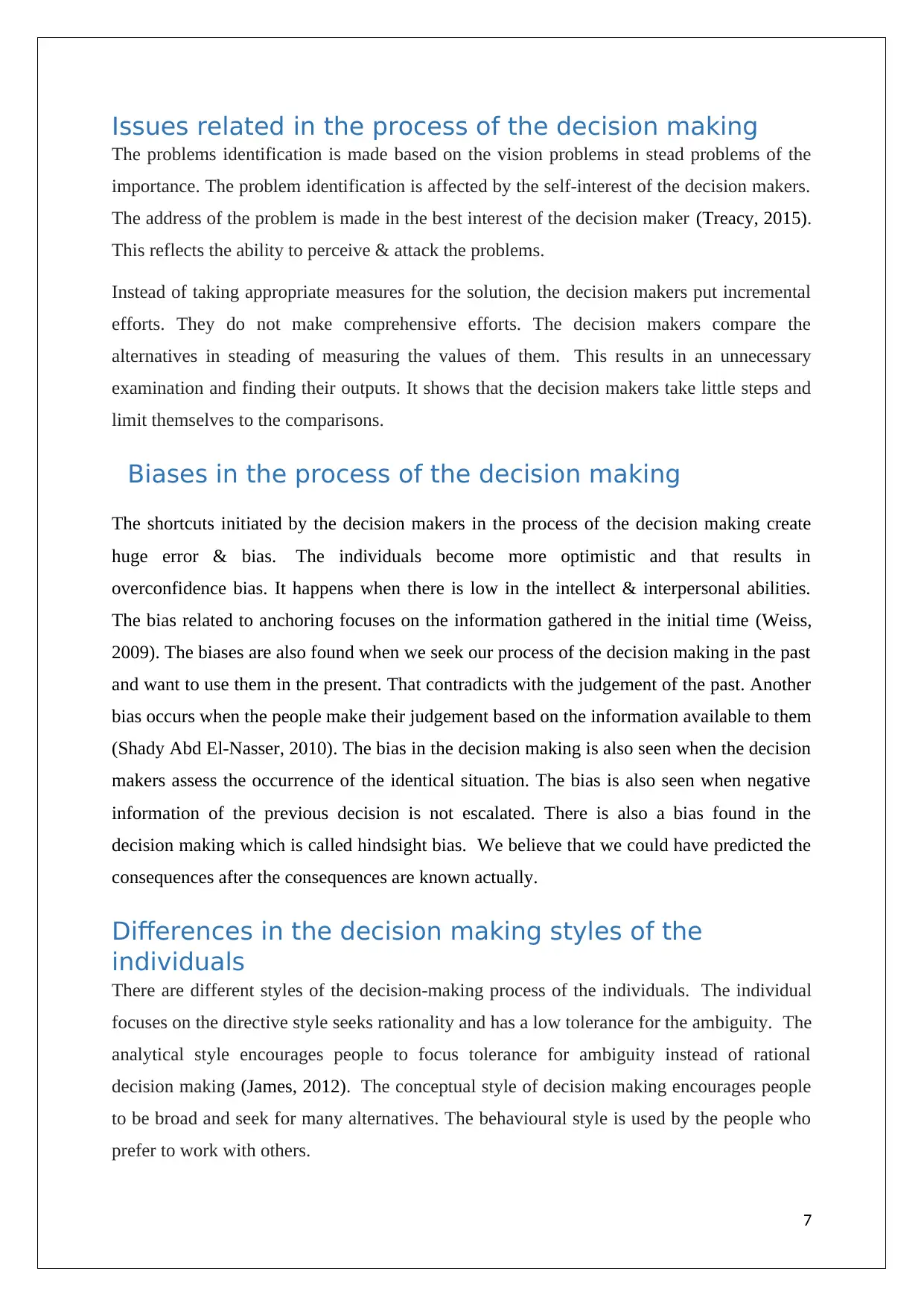
Issues related in the process of the decision making
The problems identification is made based on the vision problems in stead problems of the
importance. The problem identification is affected by the self-interest of the decision makers.
The address of the problem is made in the best interest of the decision maker (Treacy, 2015).
This reflects the ability to perceive & attack the problems.
Instead of taking appropriate measures for the solution, the decision makers put incremental
efforts. They do not make comprehensive efforts. The decision makers compare the
alternatives in steading of measuring the values of them. This results in an unnecessary
examination and finding their outputs. It shows that the decision makers take little steps and
limit themselves to the comparisons.
Biases in the process of the decision making
The shortcuts initiated by the decision makers in the process of the decision making create
huge error & bias. The individuals become more optimistic and that results in
overconfidence bias. It happens when there is low in the intellect & interpersonal abilities.
The bias related to anchoring focuses on the information gathered in the initial time (Weiss,
2009). The biases are also found when we seek our process of the decision making in the past
and want to use them in the present. That contradicts with the judgement of the past. Another
bias occurs when the people make their judgement based on the information available to them
(Shady Abd El-Nasser, 2010). The bias in the decision making is also seen when the decision
makers assess the occurrence of the identical situation. The bias is also seen when negative
information of the previous decision is not escalated. There is also a bias found in the
decision making which is called hindsight bias. We believe that we could have predicted the
consequences after the consequences are known actually.
Differences in the decision making styles of the
individuals
There are different styles of the decision-making process of the individuals. The individual
focuses on the directive style seeks rationality and has a low tolerance for the ambiguity. The
analytical style encourages people to focus tolerance for ambiguity instead of rational
decision making (James, 2012). The conceptual style of decision making encourages people
to be broad and seek for many alternatives. The behavioural style is used by the people who
prefer to work with others.
7
The problems identification is made based on the vision problems in stead problems of the
importance. The problem identification is affected by the self-interest of the decision makers.
The address of the problem is made in the best interest of the decision maker (Treacy, 2015).
This reflects the ability to perceive & attack the problems.
Instead of taking appropriate measures for the solution, the decision makers put incremental
efforts. They do not make comprehensive efforts. The decision makers compare the
alternatives in steading of measuring the values of them. This results in an unnecessary
examination and finding their outputs. It shows that the decision makers take little steps and
limit themselves to the comparisons.
Biases in the process of the decision making
The shortcuts initiated by the decision makers in the process of the decision making create
huge error & bias. The individuals become more optimistic and that results in
overconfidence bias. It happens when there is low in the intellect & interpersonal abilities.
The bias related to anchoring focuses on the information gathered in the initial time (Weiss,
2009). The biases are also found when we seek our process of the decision making in the past
and want to use them in the present. That contradicts with the judgement of the past. Another
bias occurs when the people make their judgement based on the information available to them
(Shady Abd El-Nasser, 2010). The bias in the decision making is also seen when the decision
makers assess the occurrence of the identical situation. The bias is also seen when negative
information of the previous decision is not escalated. There is also a bias found in the
decision making which is called hindsight bias. We believe that we could have predicted the
consequences after the consequences are known actually.
Differences in the decision making styles of the
individuals
There are different styles of the decision-making process of the individuals. The individual
focuses on the directive style seeks rationality and has a low tolerance for the ambiguity. The
analytical style encourages people to focus tolerance for ambiguity instead of rational
decision making (James, 2012). The conceptual style of decision making encourages people
to be broad and seek for many alternatives. The behavioural style is used by the people who
prefer to work with others.
7
Paraphrase This Document
Need a fresh take? Get an instant paraphrase of this document with our AI Paraphraser
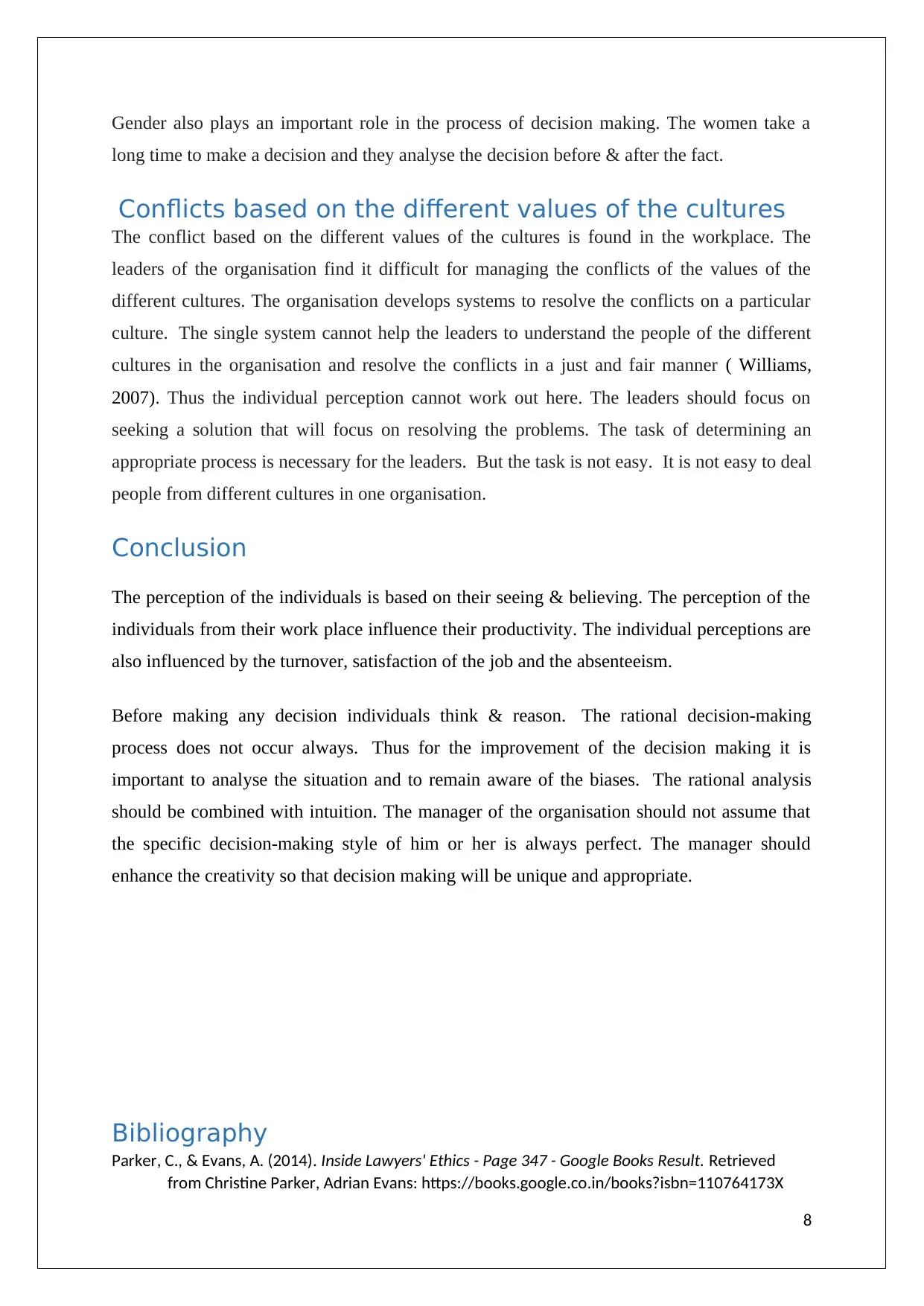
Gender also plays an important role in the process of decision making. The women take a
long time to make a decision and they analyse the decision before & after the fact.
Conflicts based on the different values of the cultures
The conflict based on the different values of the cultures is found in the workplace. The
leaders of the organisation find it difficult for managing the conflicts of the values of the
different cultures. The organisation develops systems to resolve the conflicts on a particular
culture. The single system cannot help the leaders to understand the people of the different
cultures in the organisation and resolve the conflicts in a just and fair manner ( Williams,
2007). Thus the individual perception cannot work out here. The leaders should focus on
seeking a solution that will focus on resolving the problems. The task of determining an
appropriate process is necessary for the leaders. But the task is not easy. It is not easy to deal
people from different cultures in one organisation.
Conclusion
The perception of the individuals is based on their seeing & believing. The perception of the
individuals from their work place influence their productivity. The individual perceptions are
also influenced by the turnover, satisfaction of the job and the absenteeism.
Before making any decision individuals think & reason. The rational decision-making
process does not occur always. Thus for the improvement of the decision making it is
important to analyse the situation and to remain aware of the biases. The rational analysis
should be combined with intuition. The manager of the organisation should not assume that
the specific decision-making style of him or her is always perfect. The manager should
enhance the creativity so that decision making will be unique and appropriate.
Bibliography
Parker, C., & Evans, A. (2014). Inside Lawyers' Ethics - Page 347 - Google Books Result. Retrieved
from Christine Parker, Adrian Evans: https://books.google.co.in/books?isbn=110764173X
8
long time to make a decision and they analyse the decision before & after the fact.
Conflicts based on the different values of the cultures
The conflict based on the different values of the cultures is found in the workplace. The
leaders of the organisation find it difficult for managing the conflicts of the values of the
different cultures. The organisation develops systems to resolve the conflicts on a particular
culture. The single system cannot help the leaders to understand the people of the different
cultures in the organisation and resolve the conflicts in a just and fair manner ( Williams,
2007). Thus the individual perception cannot work out here. The leaders should focus on
seeking a solution that will focus on resolving the problems. The task of determining an
appropriate process is necessary for the leaders. But the task is not easy. It is not easy to deal
people from different cultures in one organisation.
Conclusion
The perception of the individuals is based on their seeing & believing. The perception of the
individuals from their work place influence their productivity. The individual perceptions are
also influenced by the turnover, satisfaction of the job and the absenteeism.
Before making any decision individuals think & reason. The rational decision-making
process does not occur always. Thus for the improvement of the decision making it is
important to analyse the situation and to remain aware of the biases. The rational analysis
should be combined with intuition. The manager of the organisation should not assume that
the specific decision-making style of him or her is always perfect. The manager should
enhance the creativity so that decision making will be unique and appropriate.
Bibliography
Parker, C., & Evans, A. (2014). Inside Lawyers' Ethics - Page 347 - Google Books Result. Retrieved
from Christine Parker, Adrian Evans: https://books.google.co.in/books?isbn=110764173X
8
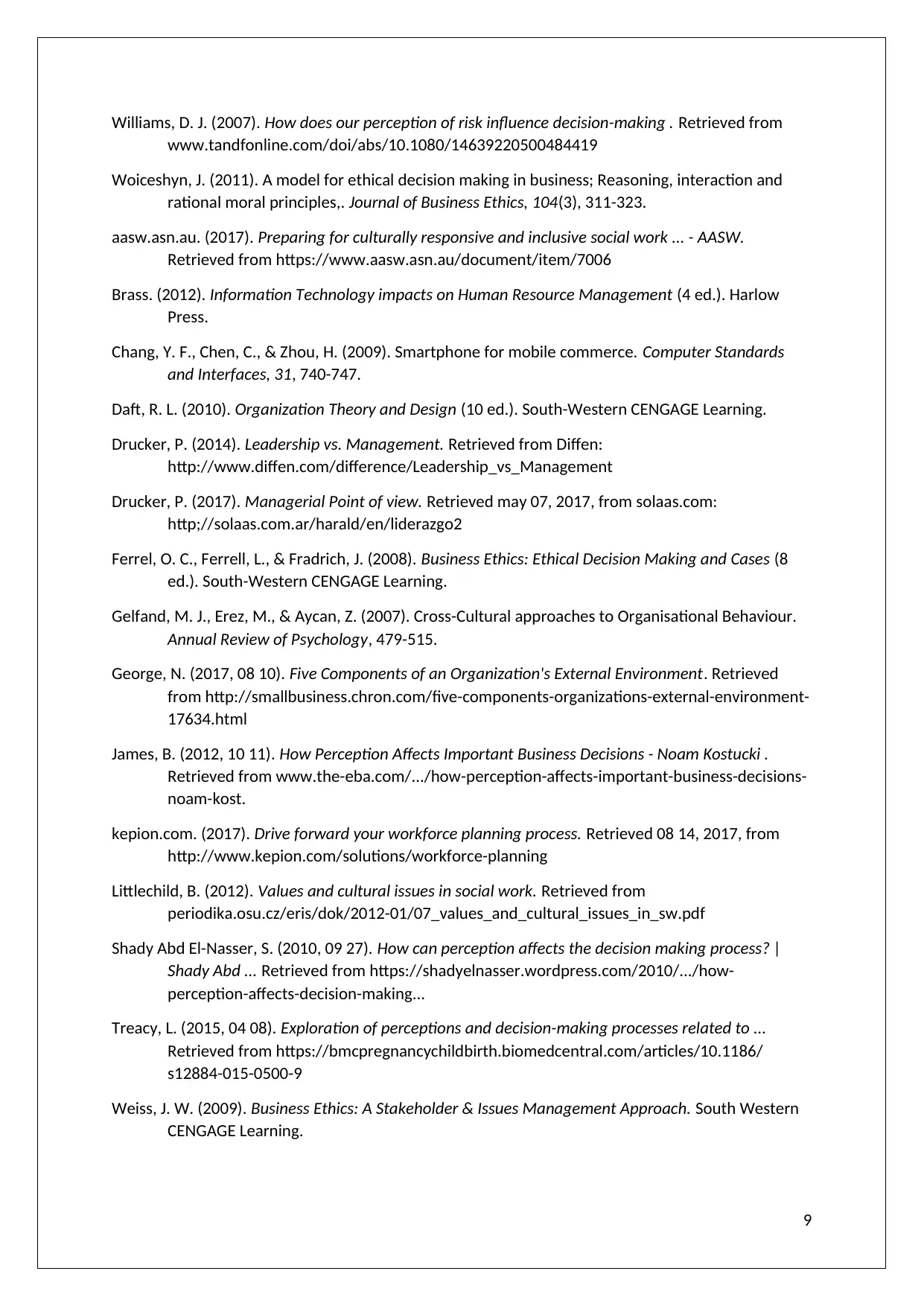
Williams, D. J. (2007). How does our perception of risk influence decision-making . Retrieved from
www.tandfonline.com/doi/abs/10.1080/14639220500484419
Woiceshyn, J. (2011). A model for ethical decision making in business; Reasoning, interaction and
rational moral principles,. Journal of Business Ethics, 104(3), 311-323.
aasw.asn.au. (2017). Preparing for culturally responsive and inclusive social work ... - AASW.
Retrieved from https://www.aasw.asn.au/document/item/7006
Brass. (2012). Information Technology impacts on Human Resource Management (4 ed.). Harlow
Press.
Chang, Y. F., Chen, C., & Zhou, H. (2009). Smartphone for mobile commerce. Computer Standards
and Interfaces, 31, 740-747.
Daft, R. L. (2010). Organization Theory and Design (10 ed.). South-Western CENGAGE Learning.
Drucker, P. (2014). Leadership vs. Management. Retrieved from Diffen:
http://www.diffen.com/difference/Leadership_vs_Management
Drucker, P. (2017). Managerial Point of view. Retrieved may 07, 2017, from solaas.com:
http;//solaas.com.ar/harald/en/liderazgo2
Ferrel, O. C., Ferrell, L., & Fradrich, J. (2008). Business Ethics: Ethical Decision Making and Cases (8
ed.). South-Western CENGAGE Learning.
Gelfand, M. J., Erez, M., & Aycan, Z. (2007). Cross-Cultural approaches to Organisational Behaviour.
Annual Review of Psychology, 479-515.
George, N. (2017, 08 10). Five Components of an Organization's External Environment. Retrieved
from http://smallbusiness.chron.com/five-components-organizations-external-environment-
17634.html
James, B. (2012, 10 11). How Perception Affects Important Business Decisions - Noam Kostucki .
Retrieved from www.the-eba.com/.../how-perception-affects-important-business-decisions-
noam-kost.
kepion.com. (2017). Drive forward your workforce planning process. Retrieved 08 14, 2017, from
http://www.kepion.com/solutions/workforce-planning
Littlechild, B. (2012). Values and cultural issues in social work. Retrieved from
periodika.osu.cz/eris/dok/2012-01/07_values_and_cultural_issues_in_sw.pdf
Shady Abd El-Nasser, S. (2010, 09 27). How can perception affects the decision making process? |
Shady Abd ... Retrieved from https://shadyelnasser.wordpress.com/2010/.../how-
perception-affects-decision-making...
Treacy, L. (2015, 04 08). Exploration of perceptions and decision-making processes related to ...
Retrieved from https://bmcpregnancychildbirth.biomedcentral.com/articles/10.1186/
s12884-015-0500-9
Weiss, J. W. (2009). Business Ethics: A Stakeholder & Issues Management Approach. South Western
CENGAGE Learning.
9
www.tandfonline.com/doi/abs/10.1080/14639220500484419
Woiceshyn, J. (2011). A model for ethical decision making in business; Reasoning, interaction and
rational moral principles,. Journal of Business Ethics, 104(3), 311-323.
aasw.asn.au. (2017). Preparing for culturally responsive and inclusive social work ... - AASW.
Retrieved from https://www.aasw.asn.au/document/item/7006
Brass. (2012). Information Technology impacts on Human Resource Management (4 ed.). Harlow
Press.
Chang, Y. F., Chen, C., & Zhou, H. (2009). Smartphone for mobile commerce. Computer Standards
and Interfaces, 31, 740-747.
Daft, R. L. (2010). Organization Theory and Design (10 ed.). South-Western CENGAGE Learning.
Drucker, P. (2014). Leadership vs. Management. Retrieved from Diffen:
http://www.diffen.com/difference/Leadership_vs_Management
Drucker, P. (2017). Managerial Point of view. Retrieved may 07, 2017, from solaas.com:
http;//solaas.com.ar/harald/en/liderazgo2
Ferrel, O. C., Ferrell, L., & Fradrich, J. (2008). Business Ethics: Ethical Decision Making and Cases (8
ed.). South-Western CENGAGE Learning.
Gelfand, M. J., Erez, M., & Aycan, Z. (2007). Cross-Cultural approaches to Organisational Behaviour.
Annual Review of Psychology, 479-515.
George, N. (2017, 08 10). Five Components of an Organization's External Environment. Retrieved
from http://smallbusiness.chron.com/five-components-organizations-external-environment-
17634.html
James, B. (2012, 10 11). How Perception Affects Important Business Decisions - Noam Kostucki .
Retrieved from www.the-eba.com/.../how-perception-affects-important-business-decisions-
noam-kost.
kepion.com. (2017). Drive forward your workforce planning process. Retrieved 08 14, 2017, from
http://www.kepion.com/solutions/workforce-planning
Littlechild, B. (2012). Values and cultural issues in social work. Retrieved from
periodika.osu.cz/eris/dok/2012-01/07_values_and_cultural_issues_in_sw.pdf
Shady Abd El-Nasser, S. (2010, 09 27). How can perception affects the decision making process? |
Shady Abd ... Retrieved from https://shadyelnasser.wordpress.com/2010/.../how-
perception-affects-decision-making...
Treacy, L. (2015, 04 08). Exploration of perceptions and decision-making processes related to ...
Retrieved from https://bmcpregnancychildbirth.biomedcentral.com/articles/10.1186/
s12884-015-0500-9
Weiss, J. W. (2009). Business Ethics: A Stakeholder & Issues Management Approach. South Western
CENGAGE Learning.
9
⊘ This is a preview!⊘
Do you want full access?
Subscribe today to unlock all pages.

Trusted by 1+ million students worldwide
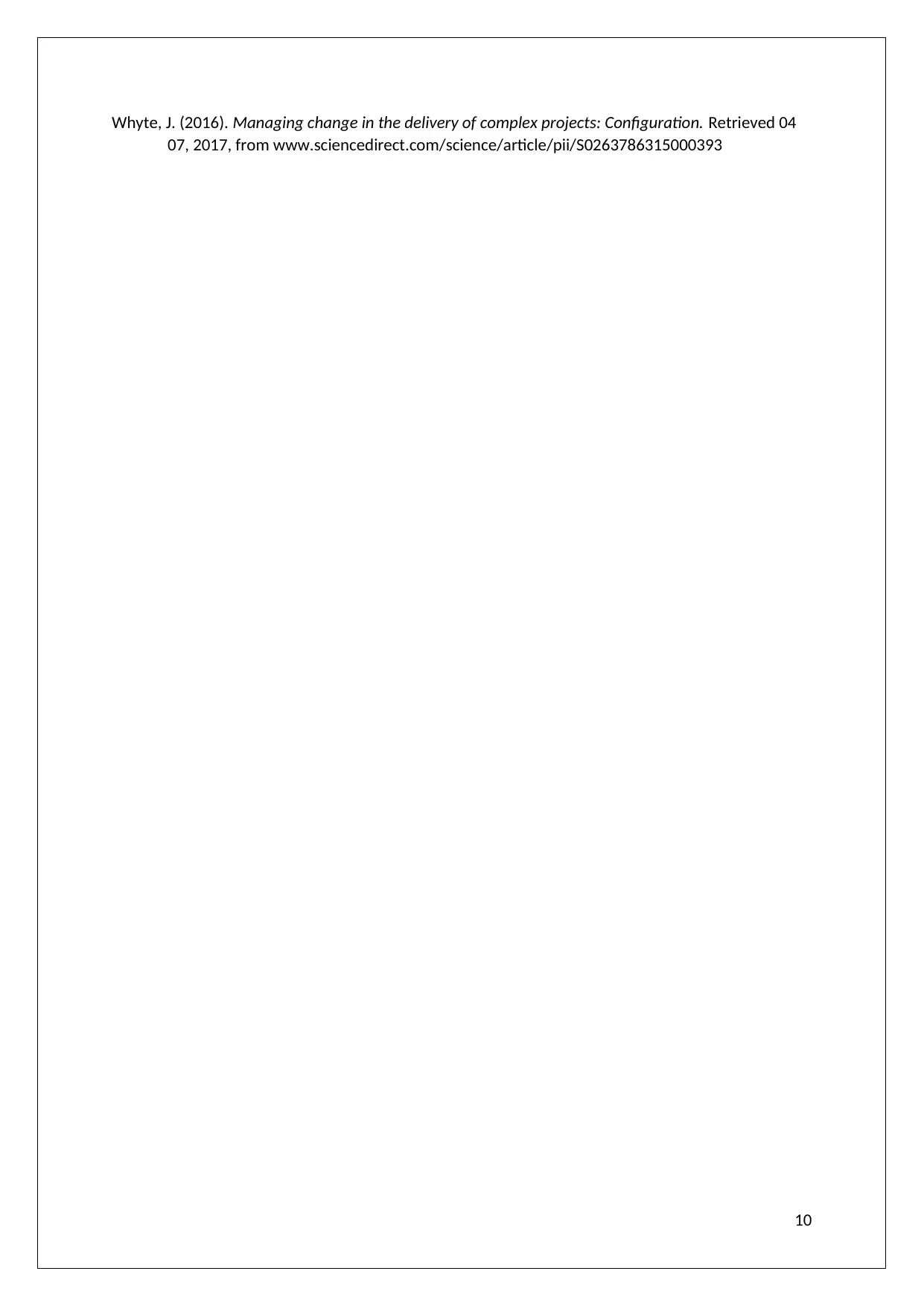
Whyte, J. (2016). Managing change in the delivery of complex projects: Configuration. Retrieved 04
07, 2017, from www.sciencedirect.com/science/article/pii/S0263786315000393
10
07, 2017, from www.sciencedirect.com/science/article/pii/S0263786315000393
10
1 out of 10
Related Documents
Your All-in-One AI-Powered Toolkit for Academic Success.
+13062052269
info@desklib.com
Available 24*7 on WhatsApp / Email
![[object Object]](/_next/static/media/star-bottom.7253800d.svg)
Unlock your academic potential
Copyright © 2020–2025 A2Z Services. All Rights Reserved. Developed and managed by ZUCOL.





